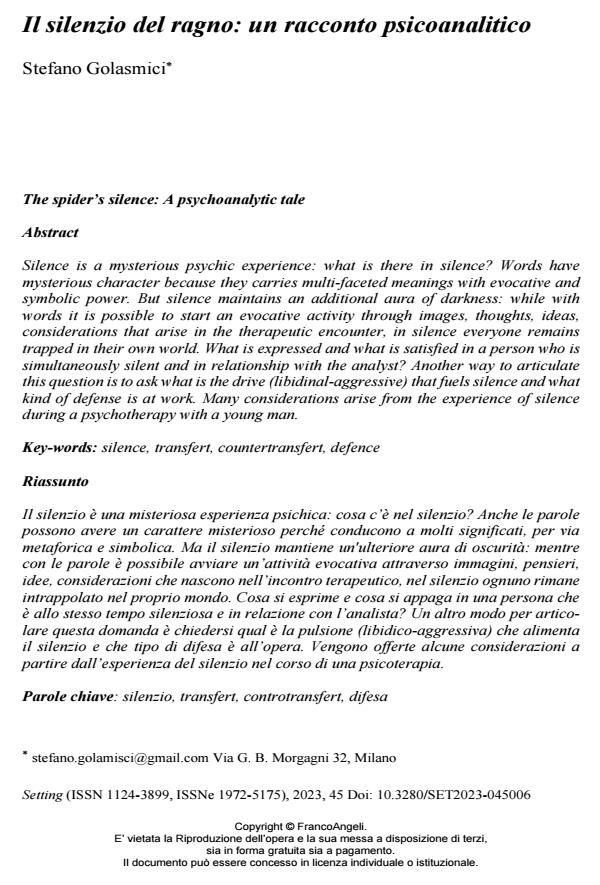The spider’s silence: A psychoanalytic tale
Journal title SETTING
Author/s Stefano Golasmici
Publishing Year 2023 Issue 2023/45 Language Italian
Pages 14 P. 75-88 File size 230 KB
DOI 10.3280/SET2023-045006
DOI is like a bar code for intellectual property: to have more infomation
click here
Below, you can see the article first page
If you want to buy this article in PDF format, you can do it, following the instructions to buy download credits

FrancoAngeli is member of Publishers International Linking Association, Inc (PILA), a not-for-profit association which run the CrossRef service enabling links to and from online scholarly content.
Silence is a mysterious psychic experience: what is there in silence? Words have mysterious character because they carries multi-faceted meanings with evocative and symbolic power. But silence maintains an additional aura of darkness: while with words it is possible to start an evocative activity through images, thoughts, ideas, considerations that arise in the therapeutic encounter, in silence everyone remains trapped in their own world. What is expressed and what is satisfied in a person who is simultaneously silent and in relationship with the analyst? Another way to articulate this question is to ask what is the drive (libidinal-aggressive) that fuels silence and what kind of defense is at work. Many considerations arise from the experience of silence during a psychotherapy with a young man.
Keywords: silence, transfert, countertransfert, defence
- Alexander F., et al. (1946). Psychoanalytic Therapy: Principles and Application. New York: Ronald Press.
- Bollas C. (1987). The shadow of the object. Psychoanalysis of the unthought known. Trad. It. L’ombra dell’oggetto. Psicoanalisi del conosciuto non pensato. Roma: Borla, 2014.
- Coltart N. (2000). Slouching toward Bethlehem. Trad. It. Pensare l’impensabile e altre esplorazioni psicoanalitiche. Milano: Raffaello Cortina, 2017.
- Cremerius J. (1985). Il mestiere dell’analista. Torino: Bollati Boringhieri.
- Cremerius J. (1991). Limiti e possibilità della tecnica psicoanalitica. Torino: Bollati Boringhieri.
- Freud S. (1892-95). Studi sull’isteria. In Opere, Vol. 1 (pp. 171-439). Torino: Bollati Boringhieri, 1967.
- Freud S. (1911-12). Tecnica della psicoanalisi. In Opere, Vol. 6 (pp. 517-541). Torino: Boringhieri. 1974.
- Freud S. (1914). Ricordare, ripetere, rielaborare. In Opere, Vol. 7 (pp. 353-361). Torino: Boringhieri, 1975.
- Freud S. (1919). Il perturbante. In Opere, Vol. 9 (pp. 81-118). Torino: Boringhieri, 1977.
- Hartmann H. (1958). Ego psychology and the problem of adaptation. Trad. It. Psicologia dell’Io e problema dell’adattamento. Torino: Bollati Boringhieri, 1966.
- Semi A. A. (2011). Il metodo delle libere associazioni. Milano: Raffaello Cortina
- Winnicott D. W. (1958). La capacità di essere solo. In Sviluppo affettivo e ambiente (pp. 29-39). Roma: Armando Editore, 1970.
Stefano Golasmici, Il silenzio del ragno: un racconto psicoanalitico in "SETTING" 45/2023, pp 75-88, DOI: 10.3280/SET2023-045006